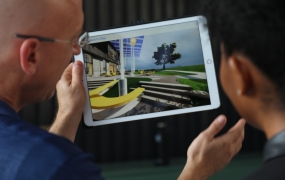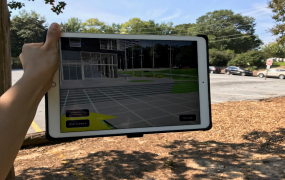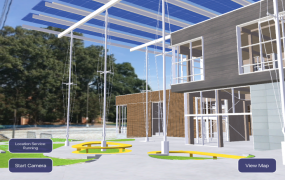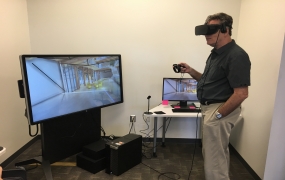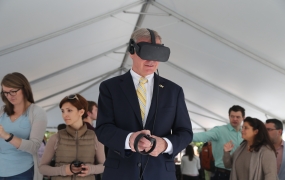Hosted by: School of Civil and Environmental Engineering
The Kendeda Building for Innovative Sustainable Design had the intention of becoming a resource for and model of sustainable design for the Southeast. This necessitated feedback from the community even in the design phase. One way to collect feedback is through crowdsourcing methods. But how do you crowdsource information for a building that has not yet been constructed?
Dr. John E. Taylor, the Frederick Law Olmstead Professor of the Georgia Tech School of Civil and Environmental Engineering, and his dynamic research team were charged with creating interactive virtual and augmented reality viewers to collect user information for the Kendeda Building for Innovative Sustainable Design.
Creating an Experience for a Building Not Yet Built
Dr. Taylor and the team quickly identified that there was not necessarily a one-size-fits-all virtual reality platform for crowdsourcing. In response to this observation, they created three different iterations of crowdsourcing platforms. Each of the platforms had their own benefits and challenges.
The three viewers were:
- The augmented reality viewer is tied to the user’s GPS location and places users in the building if they are at the building site. Using an iPad or iPhone, users walking around the site see the building superimposed over the camera’s view, as if they are walking through the building. When the building was in the pre-construction stage and still had a colorful parking lot, this was an engaging way to interact with the building. Now that the building is under construction, access to the site is more restricted–making the augmented reality viewer difficult to deploy to collect user feedback. As users shared feedback about a particular area they could tie their comments to a specific location and identify what Living Building Petal to which their feedback pertains.
- A 360-degree viewer allows users to experience 360-degree views of the building and its surroundings from a set of pre-defined locations on the site using a mobile device. Like the augmented reality viewer, as users share feedback about a particular area, they can tie their comments to a specific location and identify the Petal to which their feedback pertains.
- A full immersion virtual reality viewer enables users to experience and walk through the building and the site surrounding the building before it is built with no limitations imposed by construction on the actual site nor limitations on what parts of the building or site they may visit. Participants can even experience the building in different weather conditions, and the full immersion experience gives people the opportunity to interact with the building before it is built. The full immersion program requires a VR headset.
A Popular Response to Finding a Meaningful Experience
As mentioned above, one of the early obstacles overcome by Dr. Taylor and his research team was the realization that there was not one virtual reality platform that optimally meets every feedback requirement. This suite of virtual reality experiences allowed for project stakeholders to collect more community information and feedback. As the purpose of the reality viewers is to capture community feedback, it is beneficial to tailor the viewer to the specific type of feedback desired to help ensure a meaningful user experience. The system also collects demographic information from the users. This is an important feature as the Living Building team works to ensure that diverse feedback is collected - and, if feedback is implemented, design changes are equitable for all.
An additional challenge encountered by Dr. Taylor and the team has been the extremely positive reaction from the community! He and his team have been busy trying to fulfill the various request to present their technology to individuals and groups across campus and the greater Atlanta community.
Next steps for the project include developing methods to analyze the data, analyzing the data and experiential information collected thus far, and then publishing what they have learned about the best platforms to crowdsource design feedback.
Resources:
